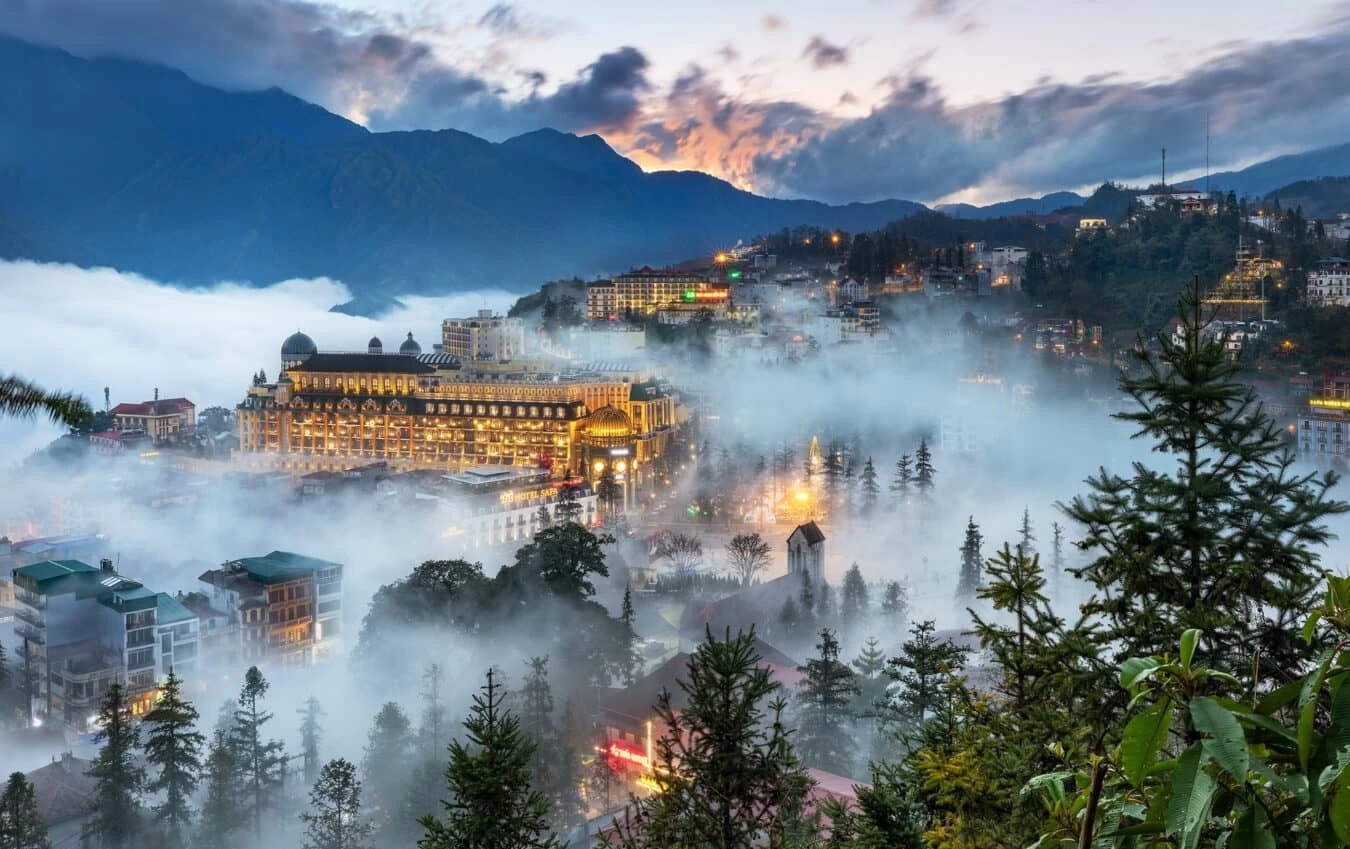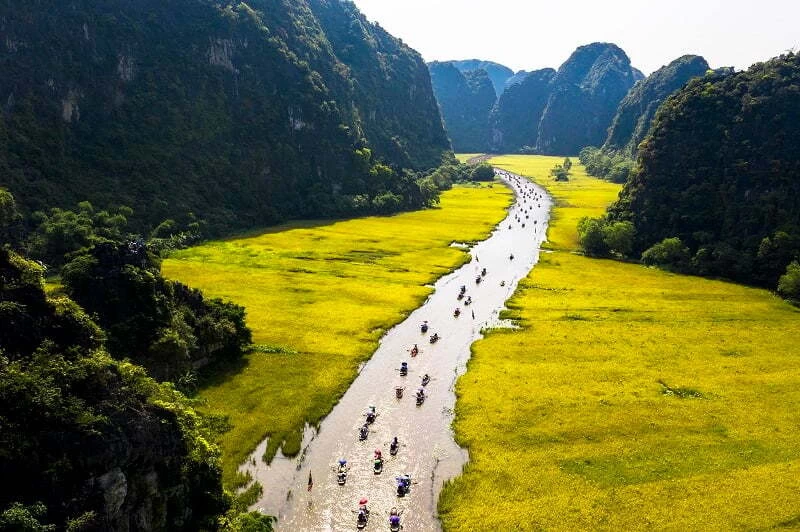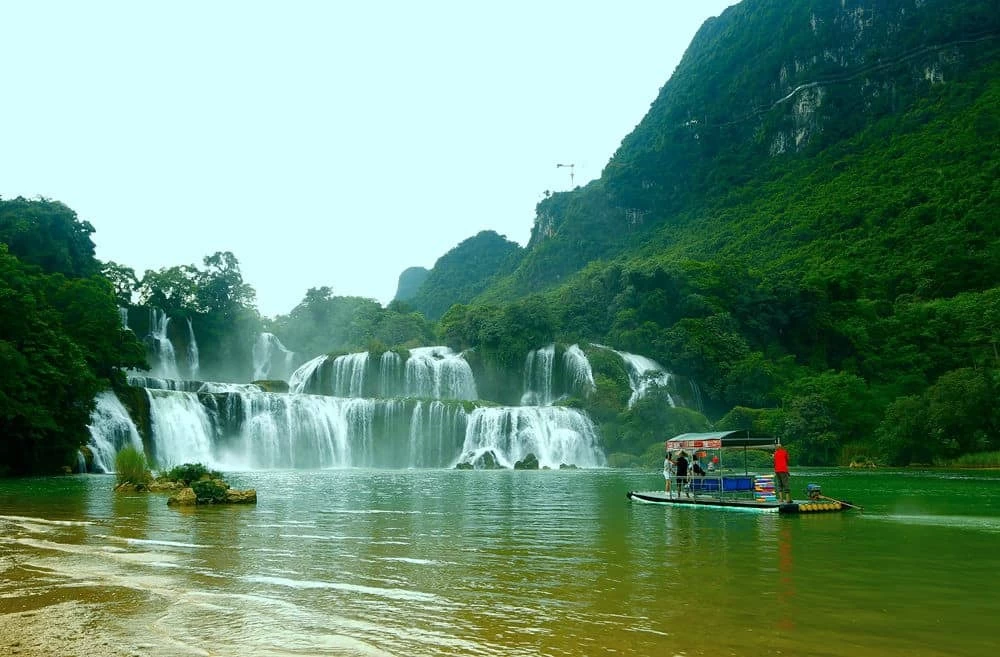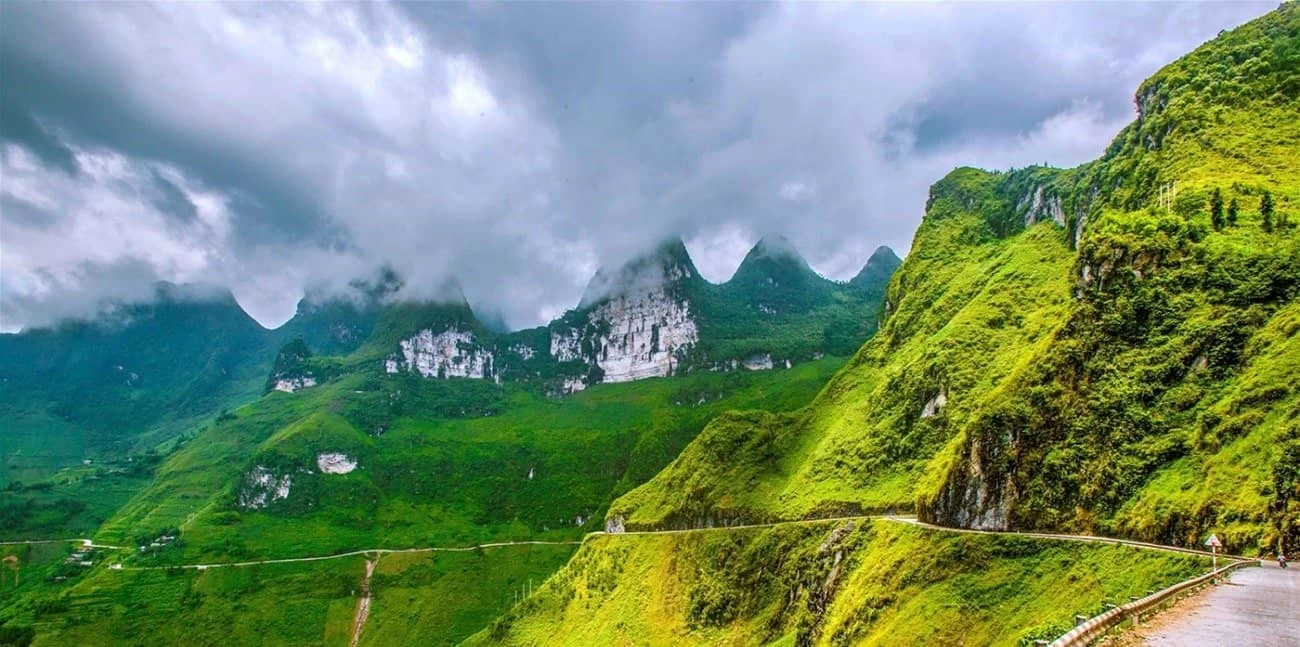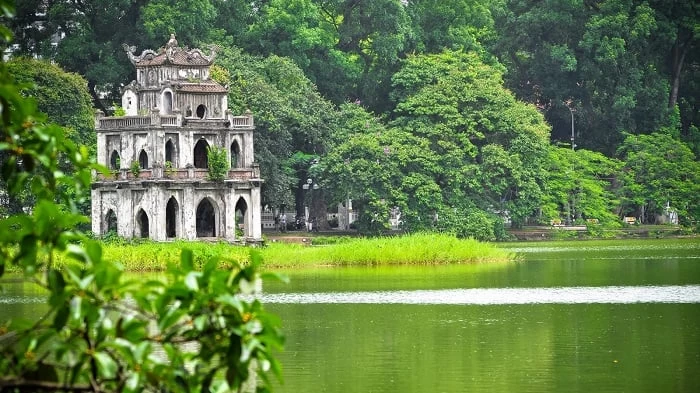
Symbol of the capital of Vietnam
Hanoi, boasting a history spanning over a millennium, transcends being merely a geographical label in the world; it embodies a lively tableau etching the imprints of time. Esteemed for its enduring legacy and the amalgamation of cultural remnants. Strolling through streets, one experiences not only the antiquity of the capital or the depth derived from historical texts but also a vibrant existence. Follow Ula Travel now to discover this beautiful city!
I. Overview of Hanoi
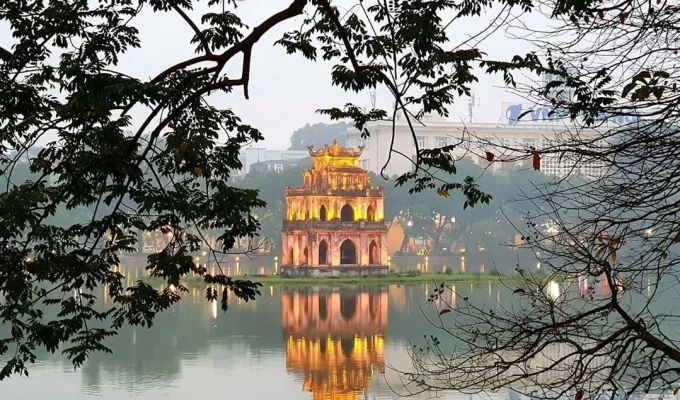
Hanoi
Located in the northern part of Vietnam, Hanoi is not just the political and administrative heart of the country but also a cultural hub. The city’s charm lies in the harmonious juxtaposition of ancient architecture, traditional customs, and a rapidly modernizing skyline. Visitors to Hanoi are often enchanted by its blend of French colonial architecture, ancient temples, and bustling streets, which together create a uniquely atmospheric cityscape.
Hanoi’s old quarter, with its narrow streets and French-style buildings, transports visitors to a bygone era, while its modern skyscrapers, shopping malls, and international hotels reflect the country’s rapid development. The city is alive with the sound of motorcycles, the smell of street food, and the sight of local vendors selling their goods along every corner.
II. Hanoi – An Ideal Destination for International Travelers
1. Why Choose Hanoi
Hanoi stands out as a destination that balances the calm, tranquility of its natural surroundings with the bustling energy of a major urban center. Visitors can enjoy the peaceful atmosphere of the city’s many lakes, parks, and gardens while also exploring its ancient streets full of history and culture.
- Historical Significance: Hanoi has been the heart of Vietnam for over a thousand years. The city is home to important landmarks like the Hoan Kiem Lake, the ancient temples, the Imperial Citadel of Thang Long, and the Ho Chi Minh Mausoleum, which offer travelers a glimpse into the country’s past.
- Cultural Richness: The city preserves its traditions through cultural practices like water puppetry, music, and local festivals. Travelers can also explore its rich architectural mix of colonial, Chinese, and traditional Vietnamese styles.
- Diverse Scenery: From the serene beauty of West Lake and Hoan Kiem Lake to the vibrant streets of the Old Quarter, Hanoi is a city of contrast. It’s an ideal place for travelers who want to explore both the peaceful and dynamic sides of Vietnam.
Whether you’re looking to immerse yourself in Vietnamese culture, learn about its history, or simply enjoy the natural beauty of the area, Hanoi offers a perfect blend of all these elements.
2. Best Time to Visit Hanoi
The best time to visit Hanoi is during the spring and autumn seasons, when the weather is most favorable for outdoor activities and sightseeing.
- Spring (February to April): The spring months in Hanoi offer a mild and pleasant climate, with temperatures ranging from 15°C to 25°C (59°F to 77°F). During this time, Hanoi experiences a period of rejuvenation, as the city’s parks and gardens are in full bloom. The weather is ideal for walking around the Old Quarter, visiting temples, and enjoying the peaceful atmosphere around the lakes. Spring is also when many traditional festivals take place, such as the Lunar New Year (Tết), offering travelers a chance to witness local customs and festivities.
- Autumn (September to November): Autumn is considered one of the best times to visit Hanoi, with cooler temperatures and a refreshing breeze. The city experiences a pleasant drop in humidity, making it a perfect time to explore Hanoi’s outdoor attractions, enjoy a boat ride on West Lake, or sit at one of the outdoor cafés. The golden light and the clear skies create a perfect backdrop for photography and sightseeing. Additionally, the city is quieter compared to the summer months, making it easier for travelers to explore without the hustle and bustle.
III. Hanoi People
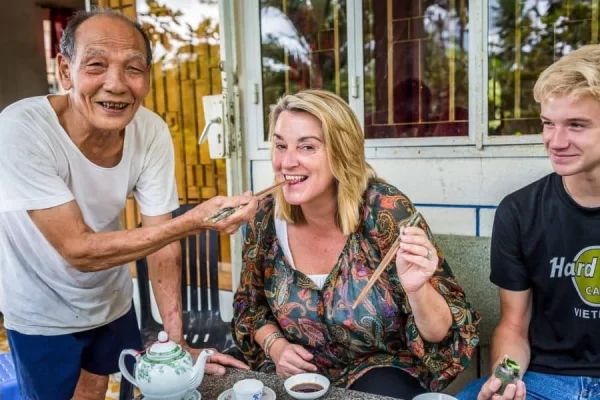
Hanoi people are always friendly and open.
Hanoians are renowned for their commitment to preserving and promoting traditional cultural values while embracing and integrating the beauty of global cultures. Life in this city vividly reflects the essence of civilization, where everyone exhibits politeness and respect towards each other.
Despite being strangers, each encounter commences with courteous greetings, leaving a lasting impression on visitors. The compassionate and peace-loving nature of the people is evident in their treatment of both nature and fellow humans. As a melting pot of diverse cultures, the capital fosters a sociable, friendly, and inclusive community.
IV. Hanoi Culture
Hanoi stands as a bustling and diverse hub, shaped by the convergence of various regional cultures resulting from multiple waves of migration. It serves as a focal point for significant political, economic, and cultural events at both national and global levels. With its cultural fabric woven from a blend of traditional and modern values, Hanoi boasts a distinctiveness that sets it apart from many other capitals worldwide.
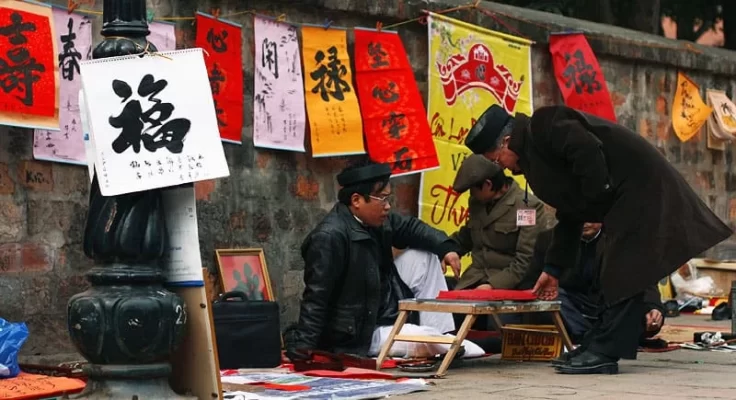
Traditional Hanoi
What sets Hanoi apart is its unique amalgamation of cultural influences from all four directions, resulting in a rich tapestry of diversity unmatched elsewhere in capital of Vietnam. Throughout the city, one can find villages showcasing Buddhist, folk, and French architectural styles, a source of excitement for tourists keen on experiencing the enduring cultural heritage amidst the bustling urban landscape of Hanoi.
Delving deeper into Hanoi’s cultural tapestry will undoubtedly enhance one’s travel experience, providing valuable insights into the city’s customs and traditions. Exploring every nook and cranny of the capital will unveil the reasons behind its unique characteristics and street layouts. It’s fascinating to note that Hanoi‘s cultural legacy spans millennia, adding depth and richness to the city’s identity.
Maybe you will be interested: Hanoi Pho And The 5 Best Places To Eat
V. Hanoi Weather
Hanoi experiences four distinct seasons, each offering its own unique charm, making it a year-round destination for travelers. Here’s a breakdown of the seasons in the capital:
- Spring: Spanning from January to April, spring brings warmer temperatures averaging around 18 degrees Celsius. It’s an ideal time to visit as you can avoid both the scorching summer heat, reaching up to 35 degrees Celsius, and the bitter cold of winter.
- Summer: From May to July, Hanoi experiences hot and sunny weather, with temperatures ranging from 30 to 32 degrees Celsius. While the days are long and sunny, heavy afternoon rains provide relief from the heat, making it a bit more bearable.
- Fall: Taking place in August, September, and October, fall marks the end of the rainy season, offering dry weather and clear skies. This is considered the best time to visit this beatiful city, with pleasant temperatures, soft sunlight, and minimal rainfall, providing ideal conditions for exploring the city and its surroundings.
- Winter: Running from November to January of the following year, winter in Hanoi is characterized by dry, cold weather, occasionally accompanied by light drizzles lasting up to a week. Although not the peak tourist season, winter attracts travelers seeking unique weather experiences.
Regardless of the season, Hanoi has something to offer to visitors throughout the year, whether it’s enjoying the lively festivals of spring, basking in the warm sunshine of summer, relishing the crisp autumn air, or experiencing the tranquil ambiance of winter.
Click here: Hanoi Weather
VI. Hanoi Attractions
1. Hoan Kiem Lake and Ngoc Son Temple
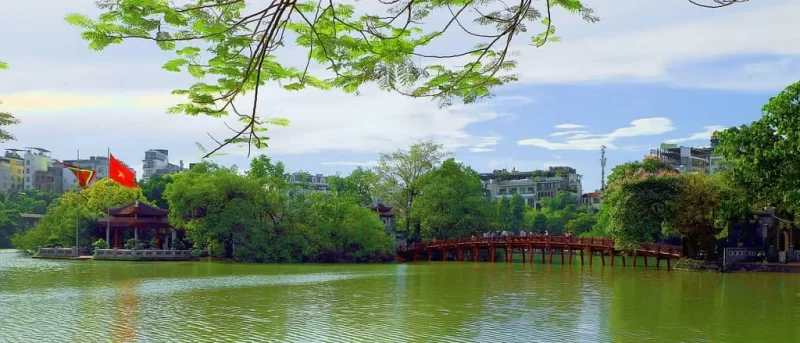
Hoan Kiem Lake and Ngoc Son Temple
Hoan Kiem Lake (Lake of the Returned Sword) is one of Hanoi’s most iconic landmarks. Located in the heart of the Old Quarter, this serene lake is not only a natural beauty but also rich in legend. According to folklore, the lake is named after a magical sword given to the Vietnamese king by the Golden Turtle God, which he later returned to the lake after defeating an invader.
At the northern edge of the lake, Ngoc Son Temple (Temple of the Jade Mountain) stands on an island connected to the shore by a red wooden bridge called the Huc Bridge. The temple is dedicated to the general who helped defeat the Chinese invaders and is a peaceful spot for reflection, with views of the surrounding lake and vibrant Hanoi life.
2. Hanoi Old Quarter
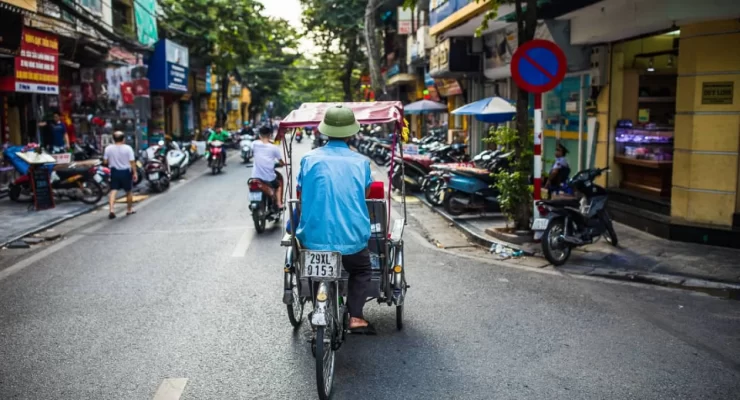
Hanoi Old Quarter
The Old Quarter of Hanoi is a historic district that embodies the essence of the city’s rich heritage. Walking through its narrow streets, visitors are transported back in time, where colonial-era buildings stand beside traditional Vietnamese architecture. The area is famous for its “36 Streets,” each named after the trades or goods sold in them, such as silk, paper, and silver.
The Old Quarter is a haven for shopping, street food, and discovering hidden gems. The colorful shops, local markets, and bustling street life are ideal for exploring on foot. Visitors can sample iconic Hanoi delicacies like Pho (Vietnamese noodle soup) and Bun Cha (grilled pork with noodles), making this area a must-see for anyone wanting to experience the soul of the city.
3. One Pillar Pagoda
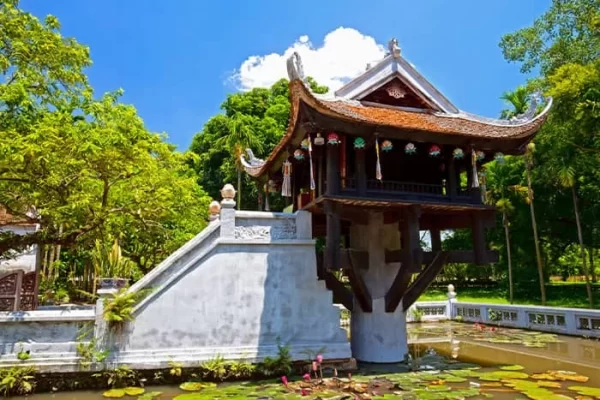
One Pillar Pagoda
The One Pillar Pagoda is a historical and architectural marvel located near the Ho Chi Minh Mausoleum. Built in 1049 during the reign of Emperor Ly Thai Tong, it is designed in the shape of a lotus flower, a symbol of purity in Buddhism. The pagoda stands on a single stone pillar emerging from the water, creating a striking and unique silhouette against the sky.
The pagoda is considered a national cultural icon and is associated with an old legend. It’s a place of reflection and one of Hanoi’s most important landmarks. Visitors can admire its simple yet profound beauty while learning about the deep Buddhist traditions it represents.
4. Ho Chi Minh Mausoleum
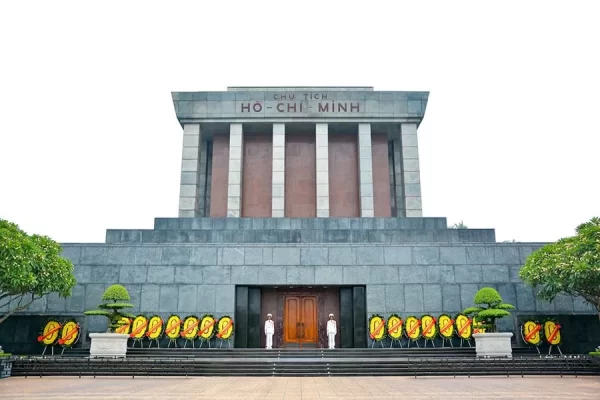
Ho Chi Minh Mausoleum
The Ho Chi Minh Mausoleum is a place of great reverence for the Vietnamese people. Located in Ba Dinh Square, it is the final resting place of President Ho Chi Minh, the leader who led Vietnam to independence from French colonial rule. The mausoleum is a grand structure with a solemn, respectful atmosphere.
Visitors can pay their respects to Ho Chi Minh’s embalmed body, which is displayed in a glass coffin. The mausoleum is also surrounded by Ho Chi Minh’s former Presidential Palace and the Ho Chi Minh Museum, where visitors can explore his life, legacy, and the history of Vietnam’s struggle for independence.
5. Tran Quoc Pagoda
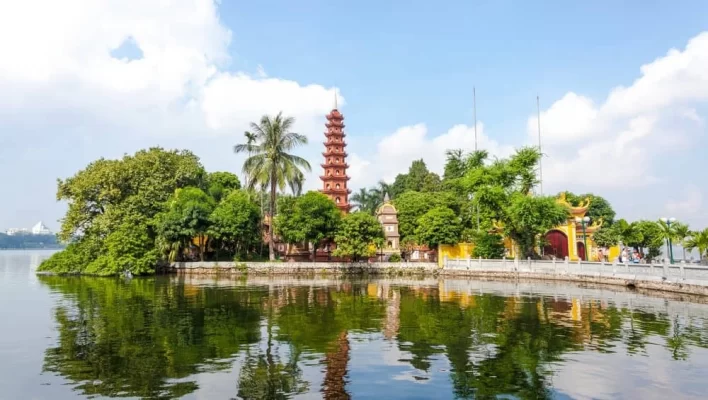
Tran Quoc Pagoda
Tran Quoc Pagoda, located on the eastern shore of West Lake, is one of the oldest and most beautiful pagodas in Hanoi. Originally built in the 6th century, the pagoda is not only an architectural masterpiece but also a center for Vietnamese Buddhism. Its serene setting beside the tranquil waters of the lake provides a peaceful escape from the busy streets of Hanoi.
The pagoda is known for its distinctive 11-story tower, which is a symbol of the pagoda’s Buddhist teachings. Visitors can admire the ancient architecture, the peaceful surroundings, and the spiritual significance of this important religious site.
6. Imperial Citadel of Thang Long
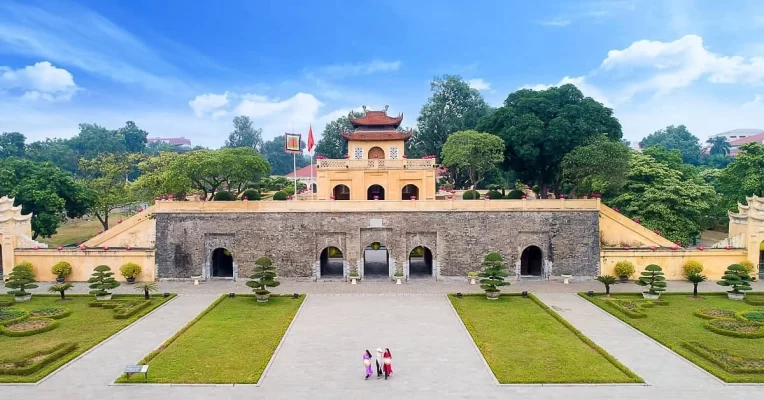
Imperial Citadel of Thang Long
The Imperial Citadel of Thang Long (Hoàng Thành Thăng Long) is a UNESCO World Heritage Site and an essential piece of Hanoi’s history. This ancient complex, located in the heart of Hanoi, was the political center of several Vietnamese dynasties, including the Ly, Tran, and Le dynasties.
The citadel includes several important sites, such as Doan Mon Gate, the Dai La Wall, and the Kinh Thiên Palace. Visitors can explore the archaeological site, where artifacts from different dynasties have been uncovered. The citadel offers a fascinating glimpse into the development of Hanoi as the capital of Vietnam, with exhibitions that highlight the city’s rich cultural and historical heritage.
7. Hoa Lo Prison
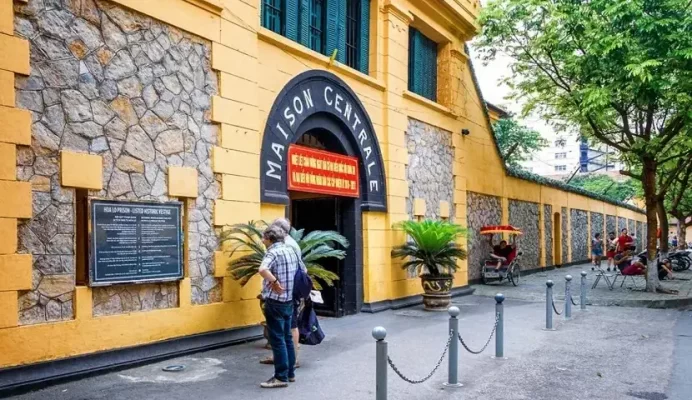
Hoa Lo Prison
Hoa Lo Prison, also known as Maison Centrale during the French colonial period, is one of the most significant historical landmarks in Hanoi, Vietnam. The prison has a deep historical connection with both the French colonial era and the Vietnam War, making it a fascinating yet somber place to visit. Originally built in the late 19th century, it was used by the French to incarcerate political prisoners, many of whom were Vietnamese revolutionaries. Later, during the Vietnam War, it became infamous for holding American POWs.
8. Temple of Literature
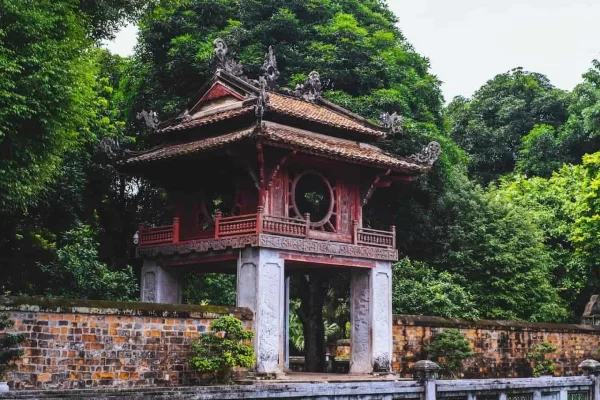
Temple of Literature
The Temple of Literature is one of Hanoi’s most iconic and historically significant landmarks. Established in 1070 during the reign of Emperor Lý Thánh Tông, this temple complex was originally built to honor Confucius, the Chinese philosopher and educator, and later became Vietnam’s first national university. This centuries-old site is not only a symbol of Hanoi’s rich cultural heritage but also a place of great intellectual and spiritual significance.
VII. What to Do When Visiting Hanoi
1. Join a Hanoi City Tour
A guided tour is one of the best ways to discover the rich history and culture of Hanoi. Whether you are a history enthusiast, a culture seeker, or simply someone who enjoys learning about new places, Hanoi offers a wide range of tours that cater to all interests.
- Historic Landmarks: A tour of the iconic landmarks such as the Hoan Kiem Lake, the Temple of Literature, and the Ho Chi Minh Mausoleum offers an insight into the country’s history and the life of Vietnam’s founding father, Ho Chi Minh.
- Heritage Tours: You can also book a tour to visit heritage sites like the Hoa Lo Prison, the Museum of Ethnology, or the Bat Trang Pottery Village. Each tour brings a deeper understanding of the local traditions, customs, and the unique way of life in Hanoi.
2. Walk Around the Old Quarter
Hanoi Old Quarter is the heart of the city, where history and modern life blend seamlessly. Taking a walk around the Old Quarter offers a unique chance to dive into the vibrant local atmosphere.
- Explore Traditional Streets: The Old Quarter consists of 36 streets, each dedicated to a specific trade or profession, like silver, silk, or herbs. As you stroll through, you’ll witness traditional Vietnamese shops selling local products, such as lacquerware, silk scarves, or handcrafted jewelry.
- Shop for unique souvenirs: As you walk through the streets, stop to shop for souvenirs. Hanoi’s Old Quarter is filled with little shops offering unique handmade goods, such as pottery, wooden carvings, and traditional fabrics, making it an excellent place to find a meaningful memento of your trip.
3. Enjoy Traditional Refreshments
Hanoi’s street food scene isn’t just about savory dishes; its traditional drinks are just as unique and flavorful.
- Iced Tea: A quintessential Hanoi experience is sipping on a refreshing glass of iced tea, served at small, local street-side cafés. It’s common to see people enjoying a cup of iced tea while chatting with friends or simply relaxing after a busy day. The tea is typically served in small plastic cups, making it easy to sip and go as you explore the city.
- Egg Coffee: Hanoi’s egg coffee is a unique creation, where a frothy mixture of egg yolks, sugar, condensed milk, and vanilla is whisked together to create a creamy and sweet drink that’s topped over a shot of strong Vietnamese coffee. A must-try for coffee lovers, this drink is a local favorite and can be found in cafés around the Old Quarter.
4. Watch a Traditional Water Puppet Show
One of the most distinctive cultural experiences in Hanoi is watching a traditional water puppet performance at the Thang Long Water Puppet Theatre. Water puppetry, a traditional Vietnamese art form, originated in the rice fields of northern Vietnam over a thousand years ago and is now one of the most beloved cultural shows in the country.



